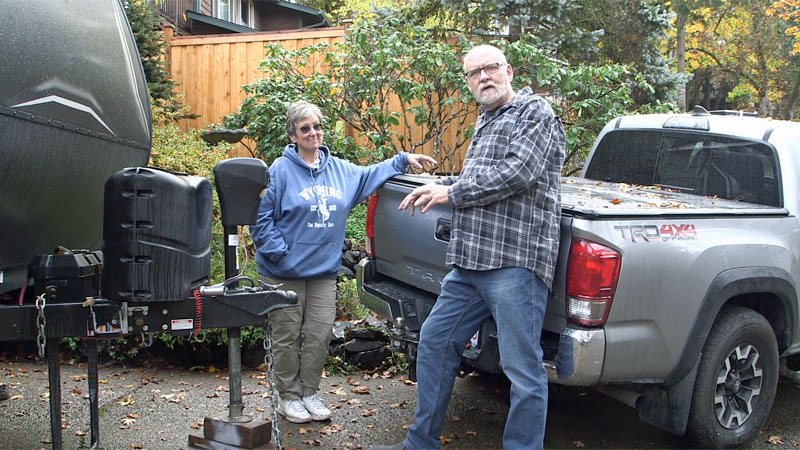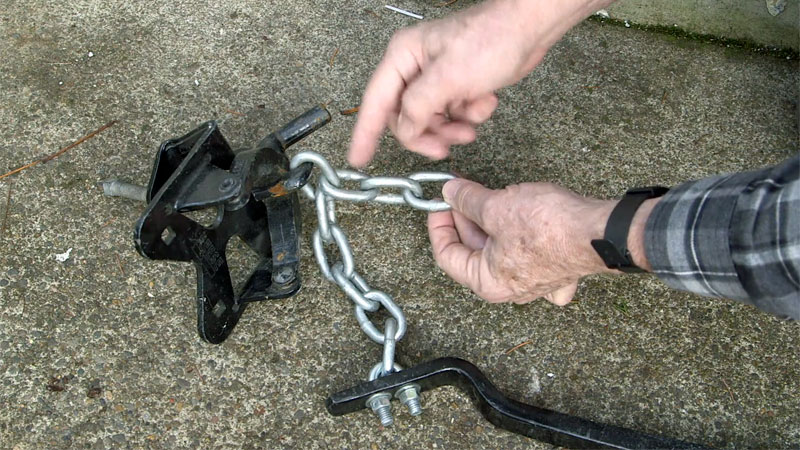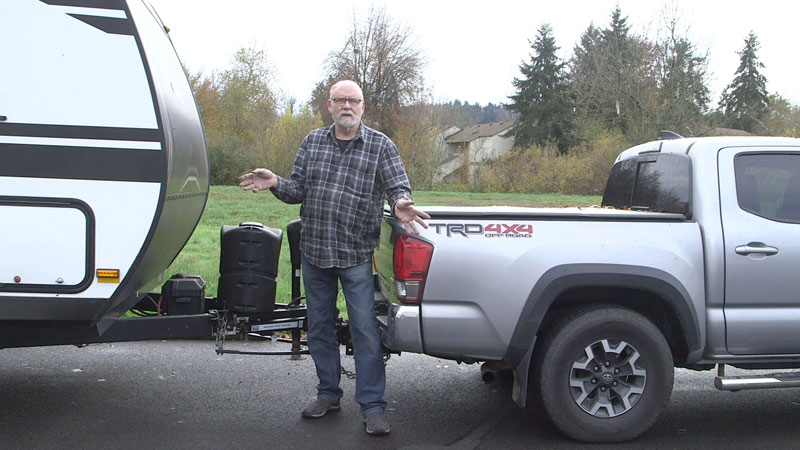RV How To Tips
Properly Adjusted Weight Distribution Systems Improve Safety and Comfort
Greetings, I’m Jeff Johnston for “RVing Today,” and this is “RV Straight Talk,” and I’m here today with my associate. Michelle Fontaine. We’re here to talk about weight distributing hitches and adjustments, and making your ride safer and more comfortable and more enjoyable. Michelle has just done a bunch of driving with this truck and trailer combination.
 Michelle: Yeah, I’ve actually driven about 10,000 miles. I could only reach 60 miles an hour. If I went over 60, it will start to feel like, as you said earlier– Like you’ve got a bungee cord under the front bumper of the truck trying to lift it up and wave it around and it got a little squirrelly. So, I thought it might be the weight combination, but we’ve determined this is a fine combination weight wise, so it’s not that.
Michelle: Yeah, I’ve actually driven about 10,000 miles. I could only reach 60 miles an hour. If I went over 60, it will start to feel like, as you said earlier– Like you’ve got a bungee cord under the front bumper of the truck trying to lift it up and wave it around and it got a little squirrelly. So, I thought it might be the weight combination, but we’ve determined this is a fine combination weight wise, so it’s not that.
Jeff: Yeah, the truck and trailer are pretty well matched. That’s not a problem. They’re both mechanically in good shape. The tires are inflated right and all that. When I drove it for a couple of hours, basically from Noma Falls here, I found exactly what you were talking about. A lot of people don’t realize that these things are adjustable. You can adjust the hitch head height, and you also can adjust the tilt. We’re gonna mainly deal with the height today and the spring bar tightening. Looking at the photos of your setup when you were sitting on flat, level ground, the trailer seems level, and the back of the truck is definitely down.
Michelle: So, lowering the hitch is going to raise the back end of the truck?
 Jeff: Yeah, mainly because we’ll lower the hitch, that’ll lower the front of the trailer a little bit relative to the truck, and then we can tighten the spring bars more than you had them. You had them on the fourth hole– one, two, three down on the chain and in the fourth hole. You were in the fourth, but we’re going to try dropping four links. This is always trial and error, and we’re going to jump into some trial, maybe run into an error, but we surely can make it better.
Jeff: Yeah, mainly because we’ll lower the hitch, that’ll lower the front of the trailer a little bit relative to the truck, and then we can tighten the spring bars more than you had them. You had them on the fourth hole– one, two, three down on the chain and in the fourth hole. You were in the fourth, but we’re going to try dropping four links. This is always trial and error, and we’re going to jump into some trial, maybe run into an error, but we surely can make it better.
We pulled the main bolts and lowered the head by one hole on the mount. After lowering the head, the mounting bolts and associated parts are reassembled and torqued to proper specs. Final safety check. Any time you work on something like this that’s this important, double check everything. We’ve got the pin in the lock back there in the receiver mount. The bolts are all tight. The hitch head is ready for the road. But double checking all these things at least once or twice does not hurt.
 We moved the truck and trailer down to a big parking lot, where we’ve got a flat surface, so we can get a real feel for how the hitch adjustment turned out. We now have four links dropped. We’re hooked into the fifth link. Before we only had three. So, we’ve tightened the bars up a little bit, and we have more space here on the rear wheel well, which indicates that the back of the truck is no longer drooping as much, and some more of the weight has been transferred to the front. So, we’ll go out and hit the road. It should be driving just fine.
We moved the truck and trailer down to a big parking lot, where we’ve got a flat surface, so we can get a real feel for how the hitch adjustment turned out. We now have four links dropped. We’re hooked into the fifth link. Before we only had three. So, we’ve tightened the bars up a little bit, and we have more space here on the rear wheel well, which indicates that the back of the truck is no longer drooping as much, and some more of the weight has been transferred to the front. So, we’ll go out and hit the road. It should be driving just fine.
But in short, consider some hitch adjustments if your truck and trailer aren’t quite handling right. This can make all the difference in the world. With the newly adjusted head and tightened-up spring bars, Michelle’s towing became far more stable.

